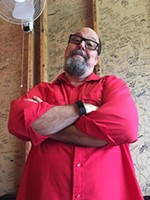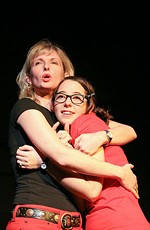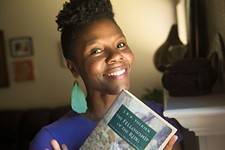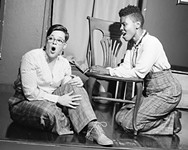Oh, the Places You'll Go!
How Parallelogramophonograph survived Scotland and became a better improv troupe
By Robert Faires, Fri., Dec. 30, 2011

After you've been standing in the rain for four hours, handing out fliers to encourage strangers in a foreign city who know nothing about you to pass on the hundreds of other offerings at this ginormous arts festival you're performing in and instead come see your show, in which you and your three friends make up a play on the spot – yes, after you've been doing this for that long and been ignored or dismissed by literally thousands of those strangers, leaving the very real possibility that tonight you could wind up with an audience smaller than your troupe – you might figure that the shine would be off this particular adventure and that you wouldn't feel much like doing improv that night or ever again.
Then again, you might end up even more excited about – and committed to – improv than you were before you made the trip. That's how it went with the members of Parallelogramophonograph. This past August, while the rest of Austin was broiling in the triple-digit heat, the intrepid quartet of Kareem Badr, Kaci Beeler, Roy Janik, and Valerie Ward, who have spent the past six years performing together under that ingenious if unwieldy moniker, were braving the Edinburgh Festival Fringe with what they advertised as "improvised plays from Austin, Texas."
Now, it wasn't as if a trip out of town was something novel for Parallelogr – oh, let's just use the shorthand version: Pgraph. The troupe has been hitting the road regularly for a few years now and can claim festival appearances in Seattle, Honolulu, Montreal, Toronto, and about 20 other cities across the continent. Indeed, Pgraph has developed such a commendable rep on the improv circuit that in just the first half of 2011, the troupe performed in Chicago; Boston; Providence, R.I.; and Winter Park, Fla.
Edinburgh, though ... well, it isn't just that it's on the far side of the Atlantic, where improv isn't as popular or evolved as in the colonies (mostly short-form, lots of games, not long on narrative); it's that the Fringe in that Scottish capital is the largest arts festival on the planet. So this little foursome from the heart of Texas would be competing for audiences with more than 2,500 other shows, and it would be responsible for recruiting its houses itself. Thus the long hours pounding the pavement, rain or shine, shoving fliers at passersby, trying to make your show sound fun, sexy, smart, unique, unmissable, even if you don't like improv – which apparently describes the vast majority of the 2 million visitors to the Edinburgh Festival Fringe. For a troupe that's enjoyed a weekly gig for five years – three and a half at ColdTowne Theater, the rest at the Hideout Theatre – that's built a steady following and some serious name recognition (with that name, how could they not?), this was a radical shift and a challenge almost as huge as the Fringe itself.
And Pgraph was committed to this for a solid month: 20 performances over three weeks. They had never been away from home or stuck with one another for that long. And since they'd had to secure their own housing, the four opted to share lodging, which ended up being a basement flat within walking distance of the venue where they were performing. It was not only close quarters for the four of them, it also came with a fifth resident: a mouse.
That relentless proximity far from home might have defeated some troupes – how many bands have split over having to spend too much time together on the road? – but there's a tightness to Pgraph, off the stage as well as on, that helped the group survive. Badr and Janik have a friendship that goes back a dozen years to their improv training together. Janik and Beeler have married since the troupe was formed. And pretty much everyone has roomed with everyone else. According to Ward, "There was one point where I was roommates with Roy, Roy was dating Kaci, and Kaci was roommates with Kareem, all at the same time." Theirs aren't just working relationships. When Pgraph isn't performing, the four still hang out together all the time. Beeler says that earlier this year a friend told her, "You guys are so lucky because your troupe is like a family more than any other troupe in town."
"They are my family," says Ward. "We feel such a strong commitment to each other. We're just lucky that we found people who gel so well together. We definitely have strengths that complement each other. Kareem's the guy who's really good at space work. Kaci's really good at making bold choices, like moving things forward, and I'm the one who's keeping track of how the story's going, thinking, 'Oh, what do we need here?' I fill in the gaps."
"I tend to be the guy who wraps up the story in a nice bow at the end," adds Janik.
Such distinctions were more pronounced, they all agree, in Pgraph's early days. Over 400 shows, they've absorbed one another's strengths and grown together as improvisers. But that doesn't stop each one from being in awe of the others. Janik recalls arriving at one of their shows after it had begun and deciding not to jump in late. So he watched the show and thought: "These guys are brilliant! I think I'm holding them back."
"It's true," echoes Beeler. "Anytime I watch any combination of them onstage and I'm in the audience, I'm always amazed and kind of wonder, 'Do I fit in with them?'"
From the perspective of the audience, the answer is unequivocally yes. Every person in Pgraph belongs there. Not that that's really news to them; the Pgraphers feel it in their shows. "The reason that we know that this works is that we so often have those shows that blink by," says Badr. "We'll do a 45- or 60-minute narrative, a fully improvised play, and it's like: Lights go down, lights come up, blink, and curtain call. No one feels they were pushing the story, but it was really a nice, tight little story."
"The shows that go really well are effortless," adds Janik. "It's like being in the zone, like anything else."
The Fringe, however – to get back to that monster of a challenge – was not like anything else.
Beeler: In Edinburgh, being together pretty much constantly for that amount of time in many different aspects of our lives, the show became a completely new thing. Where here it's kind of our work; there it was completely our pleasure to do the show and everything else was the work. It felt amazing to do the show at the end of a very long day.
Ward: Sometimes I'll come into a show [here], and I'll be like, "Oh, I don't really feel like performing tonight; I'm kinda tired." And once I get into the show, I feel amazing. But in Edinburgh, when it came time for the show, we were like, "Thank God, we can do our show now." Here, we do it for the audience and for the theatre and the community, and when we go to other festivals, we do it for the other performers who are there and the people of that city. In Edinburgh, we just had to do it for ourselves. We couldn't care about the audience because any night we could have had one person in the audience, because that's not uncommon there, and the people there were probably never going to see us again, because they live in Europe. We realized that nobody cared that we were there.
Janik: It was the first festival that we played that was not only not an improv festival; it wasn't even a comedy festival. It was an arts festival.
Beeler: We felt super out of place there. We were the strange stepchild of theatre and comedy.
Badr: We were too much comedy for theatre and too theatrical to be comedy. So, yeah, we really had to start playing for ourselves.
Yes, And ...
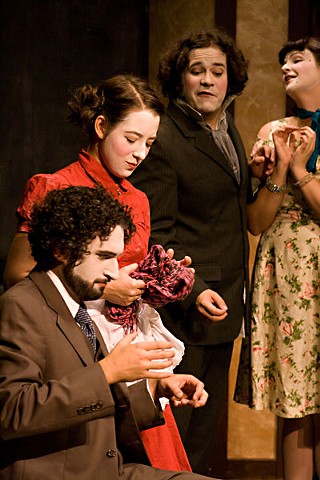
The idea for Edinburgh came as so many great moments in improv do: as an impulse. Badr had the idea back in 2006, he thinks: "Somehow it got buried in my head that this was the thing to do." Though Pgraph was just getting started, the rest of the troupe responded the way good improvisers do: by saying, "Yes, and ...." That, if you don't know, is the indispensable dictum for keeping improv moving forward: Agree to whatever has been created by your partner onstage and build on it. For four years, the troupe members kept their hands cupped around Badr's little flame of an idea, then in 2010, they began to fan it into a real conflagration. As Janik explains it on Pgraph's blog: "We decided to go for it and cleared our schedules (we're getting booked up quick these days). We got advice about where to perform, where to live, how to save money, and more. Then in November of 2010 we booked our venue and flat. Then we set about figuring out our total costs and fundraising. We designed our own posters and flyers, researched the shit out of the fest, consulted with friends who have attended, and tried to stay hopeful and positive about the whole thing."
That system of support and development is quintessential Pgraph – hell, it's in the origin of Pgraph itself. After a long, tedious search for a group name in which hundreds of options were considered and discarded, a somewhat alcohol-lubricated Janik offered "Parallelogramophone." Immediately, Badr built on it with "Parallelogramophonograph." They tried it out on some friends, and since it made them laugh, it stuck. "It's definitely memorable," says Ward. "And ridiculous."
The troupe applies the same approach in the creation of its homegrown formats. Beeler's love of French farce led her to suggest that the troupe develop a way to improvise one. Even though the other three members had no real knowledge of the genre, they said yes and began researching it and discussing it, first reading Molière and watching filmed productions of his plays and then gravitating toward Feydeau, whose door-slamming romps gave them a great foundation for improvisation. Janik says that they've applied the same process to adapt other genres into improv formats: four to six weeks of reading scripts and watching films, after which they create exercises based on the common elements that they've identified in the material. "The main thing we're going for is the tone of the show – what sort of people exist in this world, what's the world like, what's the general mood – and we keep the structure at a bare minimum. Like in Screwball [Comedy], we know there's a couple that won't like each other at the beginning and they'll like each other at the end, and that's about it."
Perusing the list of Pgraph formats is like scanning a shelf at the library: French Farce, Screwball Comedy, Jane Austen meets Raymond Chandler, Grimm's Fairy Tales, Villainy, and a nod to science-fiction films rooted in isolation and alienation (Solaris, Moon, 2001: A Space Odyssey). In January, a new format debuts: Reverend Goodman's Cure-All Elixir Traveling Revue, riffing on old medicine shows and vaudeville with the Pgraphers playing "scoundrels and ne'er-do-wells disguised as good Christian men and women presenting morality tales and miracle cures," says Beeler.
Its devotion to narrative is one of the qualities that distinguishes Pgraph from the dozens of other improv groups that have sprouted in Austin over the past decade. Other improvisers and troupes have developed the occasional format around a literary style or specific work, but Pgraphers have made it the core of their work. They're addicted to storytelling, and they have to restlessly pursue it through their performances. "We're like the champions of story because we all study it so much," says Ward. "We're the torchbearers of narrative to a certain extent," adds Badr. "If students of other schools [of improv] say, 'Narrative can't be done; it doesn't work; it's too prescriptive,' the counterexample is almost always us."
Pgraph's standing as a model in improvising narrative is the direct result of the troupe working to improve the way they tell stories. "Screwball came out of the fact that we didn't have a lot of strong love stories, and Villainy came about because we were letting the protagonist win all the time," says Janik. Adds Badr: "The new formats come from one of two things. Either it's we haven't done a new format in a while: 'Oh, this thing will be fun, let's try this.' Or it comes from: 'We suck at this thing. Let's develop a show that will force us to tackle this [problem].'"
"And after that run is over, it becomes part of who we are onstage," says Janik. "Now we play bastards all the time, and now we tell love stories all the time, and it doesn't have to be through Villainy or screwball comedy."
Eris 2035 was a chance for Pgraph to try to explore stories that were, well, to be frank about it, bleak. The format wasn't intended to spoof brooding sci-fi films as much as walk in their Beckettian moon boots. "We set out to tackle a genre whose main characteristics are that it's alienating and disturbing," says Janik. "Up until we did it, we were like, 'I don't know if this is really gonna work,'" says Badr. "And even after we did it, there were shows where we were like, 'Yeah, we hit that exactly as we wanted, but I don't think the audience liked it.'"
"It's sometimes hard for us because we want to give the audience a good time so deeply within ourselves, like that's really a huge basis for our group," says Beeler. "There were people who were big fans of those films who really, really liked it, and that was what made it all worth it for me. Then I was like, 'OK, it's not like there's not an audience for this; it's just that it's smaller.'"
But while Eris 2035 wasn't Pgraph's most popular show, audiences still turned out for it. Janik feels that's a sign of their familiarity with and faith in Pgraph: "There are formats that we do where the audience will come in and won't have any concept of what they're gonna see. By and large, I think that audiences are willing to give you the benefit of the doubt."
In Austin, maybe; in Edinburgh, where audiences didn't know Pgraph from P. Diddy, not so much. At one point, the only reason a group of people came to see the show was because they had agreed to go to the first show they received a flier for. And they stood by that vow, even though they hated improv. Yet it resulted in Pgraph's best audience comment ever: "Improvised comedy theatre was a genre which I previously wouldn't go within a mile of," wrote one member of that group afterward. "But we said that whoever canvassed us first we would attend their show irregardless. What an eye opener! Fantastic acting, genuinely funny and a joy to watch the story unfold. Brilliant!"
But a new fan wasn't all that came out of the trip. The Pgraphers were inspired to create a new format based on another Fringe show they saw called Unanswered, We Ride. "That show featured a single character monologizing throughout, as other characters and scenes wove in and out of her talking," writes Janik on the blog. "The result is a show that's a mosaic of scene snippets, memories, and thoughts. We decided to take that on as our structure." It was another bold experiment for Pgraph, since the troupe typically stays away from monologues or giving any one character too much focus. But when the Pgraphers tested it out at the Out of Bounds Comedy Festival just after their return to Austin, they succeeded in creating a poignant tale of the relationship between a father and daughter as she seeks independence and he ages.
"I love it when a show feels effortless, and this felt that way," says Janik. "We just flowed wherever the show took us, and because there was no pressure to make each scene complete, we didn't have to worry about ending things on huge laughs or anything. In fact, we heard afterwards from various people that there was some crying going on at various points. Not bad for an improv show."
Clearly, their Fringe journey gave the Pgraphers more places to explore than the side streets of Edinburgh. It took them to some new levels of improv, a fact that Beeler is quick to appreciate: "It was so amazing just to have all that time to focus on making this product the best thing that it could be and really thinking about every aspect of our theatre company and getting to work on it nonstop."
To which Ward adds: "And the fact that we did make connections with people, people who just randomly came in, not knowing who we are or what we're about, and just took a chance on us and then liked it. That was affirming that we're doing the right thing."
"On a mass level, no one gives a shit," says Badr. "On the other hand –"
"The few shits that were given were really appreciated," says Ward.
So would that inspire Pgraph to return to the Edinburgh?
No, say all the members of Parallel-ogramophonograph without hesitation and in unison. Then Badr sums it up: "Totally worth it. Never need to go back."
Parallelogramophonograph performs in the Spectacle every Friday, 10pm, at the Hideout Theatre, 617 Congress. For more information, visit www.pgraph.com.





